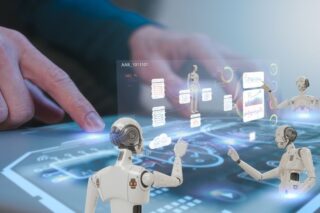Artificial intelligence is revolutionizing the entire financial industry. AI has the potential to improve decision-making, optimize business processes and enhance the customer experience. We interviewed Sitraka Forler, Data Consultant at Square Management Luxembourg (formerly Initio). We discussed the concrete applications of AI in financial services, the opportunities it generates as well as the real risks it poses.
AI, with its high-profile tools like ChatGPT, is invading every part of society. And it’s revolutionizing the financial industry.
Using techniques such as machine learning, predictive analytics, and image recognition, banks, and insurance companies are now able to examine large amounts of data and extract useful information.
Sitraka Forler is a consultant at Square Management Luxembourg (formerly Initio). He supports players in the world of finance and insurance in their strategic transformation, in particular thanks to AI.

At Square Management, what AI solutions do you develop for your clients (banks and insurance companies)?
Sitraka Forler: “We are called by companies for different subjects. One of the subjects is compliance with the GDPR. There are still a lot of companies that are fined for not complying with data protection regulations. We help companies across the entire data lifecycle. So from the ingestion of data that must comply with the European GDPR regulations to the improvement of AI models that these companies want to have or were able to build some time ago. Whether it is in credit scoring or in the classification of their verbatims, companies are using AI more and more.
We are also working on a new product for one of our clients that allows them to monitor the so-called IFRS accounting standards. Our solution is in 3 parts. First, we use web scraping to monitor everything related to ESG. Second, we use NLP to analyze texts to support the implementation of IFRS accounting standards (IFRS 17 for insurance, IFRS 9 for financial instruments). And finally, we work on the explainability of predictions.
For all these subjects, we first recover the numerical data from clients. We clean up this data; AI is above all a lot of data cleaning! From there, we design AI models that we then fine-tune to best meet the specific needs of our customers. And to do so we integrate all AI models, including LSTM models as well as ChatGPT.”


How is AI currently being used in the financial and banking sector?
Sitraka Forler: “AI is being used in financial services to improve decision making, optimize business processes and operational efficiency, and enhance the customer experience. Financial firms use machine learning algorithms to analyze large amounts of financial data in real time, extracting useful information to make informed decisions.
For example, it is used to automate manual and repetitive processes such as account openings, customer identity verification, regulatory compliance, etc. Customers don’t necessarily realize it, but if today you can open a bank account from your smartphone, it’s thanks to AI.
AI also allows for better risk analysis, especially when granting credit. AI models are used to analyze credit data and risk profiles of customers to determine the potential risk of default and decide whether or not a loan should be granted.
AI also enables financial firms to detect fraud more quickly. It can spot suspicious and fraudulent transactions by analyzing transaction patterns, customer behaviors and account history data.
It is also used for predictive analysis. AI can predict market trends, interest rates, currency fluctuations, etc. This can allow banks to develop new and innovative products and services.
The general idea is that AI can produce the maximum value with the minimum effort. This speeds up the decision-making process, more things can be processed, which creates wealth and value. And for very little money.”

How can AI detect fraud?
Sitraka Forler: “AI can identify particular characteristics or patterns. It is able to detect when a person, who says he or she comes from one country, makes all of his or her transactions in another. Until now, there were transaction thresholds below which fraudsters were less detectable. But AI is now able to detect these behaviors. A human could do it in days for a customer. AI does it in seconds and therefore makes it easier to identify more fraudsters.”

You say banks are using AI to improve the customer experience. How?
Sitraka Forler: “AI can help improve the customer experience by providing quick and accurate answers to customer questions, via chatbots or virtual assistants. 10 years ago, we used LSTM models, which were very limited. Today, we have switched to transformer models. These are the large language models that were presented in the academic paper Attention is All You Need.
AI can also allow for increased personalization of financial services. By using recommendation algorithms, banks can offer products and services tailored to the individual needs of their customers.
For portfolio managers, AI helps them make informed investment decisions through accurate analysis of market data.”

When we think of financial services, we think of high-frequency trading, which has already been using automation for years. What is new today with AI?
Sitraka Forler: “High frequency trading (HFT) is the application of fixed rules that will be applied as soon as the necessary conditions are met, it is not really AI. It’s more like if… else… If a ton of sugar costs €450, then launching such orders is intelligent. Being smart is learning from the results. This is reinforcement learning and this is what is new and different.
AI has the ability to analyze huge amounts of data and to make rules from its analysis. It can write the if…else rules itself, whereas before it was us humans who wrote them, and moreover, we could only write a limited number of them. AI can decide if the best threshold to sell is at €450 or €447 per ton.
But you need to have a guard and there always has to be human validation. There have already been two cases of mini stock market crashes with high frequency trading. The conditions were met and chained very quickly, without knowing why and without human intervention, and it led to a mini crash.”

So what risks does AI pose to the financial sector?
Sitraka Forler: “Banks and industries cannot afford to do deep learning. They do simple AI, simple predictions, simple linear regressions, OLS or random forests. Nobody really dares to use deep learning because the question of the explicability of the models arises.
ChatGPT, for example, is able to answer many questions, but if we ask it to explain why it answers such and such a thing twice, it will answer two different things. Explainability is not there. But in the banking sector, explainability is essential because the system is based on trust, and trust cannot depend on black boxes.
Let’s take the case of a bank that does not grant a loan because a black box has said that there is a risk of default without giving any explanation. This can be a problem. Moreover, in the USA, there are already legal proceedings underway against banks that have refused to grant loans on the basis of predictions made by AI for which we do not know the reasons.
The European Commission is very cautious on this question of explainability and it is a subject we are working on at Square Management.”










